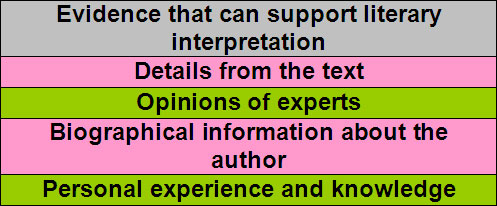 username@email.com
username@email.com
In this lesson, you will learn how to summarize the key components of a speech and identify a speech’s point of view and tone.
The easiest way to improve your comprehension of oral presentations is to take careful notes. It is virtually impossible to remember the key points of all but the very shortest of speeches without some form of written record.
In your notes, you will want to identify the main point or idea of a speech as well as the evidence that’s offered in support of it. Most speeches are structured like essays in that they introduce their main idea either at the beginning or at the end.
Oftentimes speakers will employ a circular structure and introduce their main idea early, offer supporting evidence in the body of the speech, and then come back to the main idea as the speech closes.
Speakers can rely on a wide variety of evidence to support their main point. Some of the more common types of supporting evidence include:

A previous lesson introduced the idea of conclusion and premise indicators. These trigger words turn up in oral presentations and speeches with great regularity and help identify key components.
Here is a speech for practice. Click to open a pop-up window containing the text of the Gettysburg Address. Read it once, and take notes while you do so. When you’re finished, close the window, and answer the following question using only your notes as a reference.
Which of the following most accurately characterizes the main point and supporting evidence of Lincoln’s speech?
Identifying a speaker’s point of view toward the subject matter of his or her speech is one of the keys to gaining a complete and nuanced understanding of the speech. Point of view is a speaker’s attitude or position toward the subject matter of his or her speech.
Recognizing a speaker’s point of view goes hand in hand with recognizing and identifying a speech’s tone, its emotional quality, and manner of expression.
The Gettysburg Address owes much of its fame to Lincoln’s deftness in articulating a widely shared point of view: he humbly and eloquently pays homage to the fallen soldiers while reminding listeners of the nobility of the cause for which the soldiers died.
To recognize a speaker’s point of view, it helps to first characterize the emotional tenor of the speech. Almost all speakers’ points of view fall under one of these three broad headings:
|
Negative |
Neutral |
Positive |
You would group The Gettysburg Address under the positive heading. Even though the speech is not lighthearted or upbeat, Lincoln’s attitude toward his material is respectful and appreciative.
Once you’ve broadly characterized a speaker’s point of view, you can move toward a more specific description. A wide range of more specific terms fits under each of those three headings. For example, each of the following might be a more specific characterization of a point of view that you initially labeled “positive.”
Obviously there is a vast difference between a speaker who is enthused and excited about a topic and one who is cautiously optimistic about it. However, beginning with a general characterization focuses your thinking and makes it easier to arrive at one of these tailored descriptions.
Here’s a quick practice question: Which of the following is the most accurate broad characterization of this speaker’s point of view?
Fans, for the past two weeks you have been reading about the bad break I got. Yet today I consider myself the luckiest man on the face of this earth. I have been in ballparks for seventeen years and never received anything but kindness and encouragement from you fans. Look at these grand men. Which of you wouldn’t consider it the highlight of his career just to associate with them for even one day? Sure I’m lucky … I may have had a tough break, but I have an awful lot to live for.
—From Lou Gehrig’s farewell speech at Yankee Stadium, July 4, 1939
How was it that we were able to label Lou Gehrig’s point of view toward his retirement?
Just as terms like premise and conclusion indicators point out different parts of an argument, emotionally significant words play a key role in identifying a speaker’s point of view.
Gehrig’s use of words and phrases like “luckiest man on the face of the earth,” “never received anything but kindness and encouragement,” and “I have an awful lot to live for” establishes his point of view.
In The Gettysburg Address, phrases like “altogether fitting and proper,” “so nobly advanced,” and “increased devotion” provide clear evidence of Lincoln’s point of view.
So, to identify a speaker’s point of view:
Here’s a more difficult question to practice with:
How would you describe Woodrow Wilson’s point of view toward the Russian people in the following passage:
There is, moreover, a voice calling for these definitions of principle and of purpose which is, it seems to me, more thrilling and more compelling than any of the many moving voices with which the troubled air of the world is filled. It is the voice of the Russian people. They are prostrate and all but hopeless, it would seem, before the grim power of Germany, which has hitherto known no relenting and no pity. . . . And yet their soul is not subservient. They will not yield either in principle or in action.
—From the Fourteen Points speech to Congress, July 8, 1918